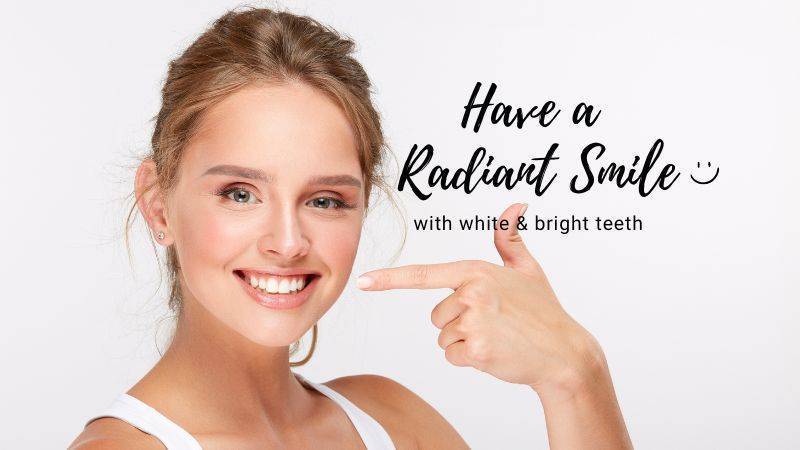A bright, white smile can boost confidence and improve one’s overall appearance.
Highlights
A survey indicates that 80% of adults aged 18-49 desire whiter teeth, and they spent thousands on teeth whitening products.
If you’re seeking a brighter smile, professional teeth whitening is a frequently chosen option due to its efficiency, safety, and effectiveness.
However, there are several factors to take into account before making a decision, such as the cost, your lifestyle habits, and whether a comprehensive in-office treatment or a custom take-home-tray would be the more suitable choice for you.
What leads to a yellow appearance of teeth?

Due to Teeth Discoloration teeth lose their bright, white luster and appear dull for various factors, including
- Genetics
- Aging
- Consumption of staining substances
- Poor oral hygiene
Typically, regular cleaning and whitening treatments can address this type of discoloration.
Nevertheless, in some cases, teeth may appear yellow due to the erosion of the hard enamel, exposing the underlying dentin. Dentin is a naturally yellow, bony tissue situated beneath the enamel.
The most common teeth-whitening agents contain hydrogen peroxide or carbamide peroxide, which breaks down into oxygen molecules that penetrate the enamel and break up stains.
Some Effective Methods for Teeth Whitening
 There are several clinical ways to whiten teeth in India. Here are some of the most common options:
There are several clinical ways to whiten teeth in India. Here are some of the most common options:
Professional teeth whitening
This is a popular option that involves using a bleaching agent to whiten teeth. This treatment is done by a dentist, and it can help to lighten the color of your teeth by several shades.
The dentist will apply the whitening solution to your teeth and may use a special light to activate the bleaching agent. This treatment typically takes about an hour, and you may need multiple sessions to achieve the desired results.
Laser teeth whitening

This is a similar treatment to professional teeth whitening, but it uses a special laser to activate the bleaching agent. This treatment is faster than traditional teeth whitening and may be more effective for certain types of staining.
Home teeth whitening kits
These kits contain a whitening gel that you apply to your teeth using a tray or strip.
They are available over-the-counter at drugstores and supermarkets, but it’s recommended to consult with a dentist before using them. While home whitening kits are generally safe, they may cause sensitivity or gum irritation if not used correctly.
Teeth whitening toothpaste
These toothpaste contain mild abrasives that help to remove surface stains from the teeth. They are a more affordable and convenient option compared to other clinical treatments, but they may not be as effective for more stubborn stains.
Hydrogen Peroxide

The primary products used for professional teeth whitening are hydrogen peroxide and carbamide peroxide. Unlike whitening toothpaste which uses an abrasive ingredient to remove surface-level stains, these whitening agents contain oxygen molecules that work to weaken tooth stains on a molecular level.
Hydrogen peroxide is a common bleaching agent found in many OTC teeth whitening products.
In-office whitening uses a high percentage of hydrogen peroxide because dentists can isolate the teeth and protect the patient’s gums with a special rubber dam to prevent burning.
There are several types of in-office teeth whitening treatments, including a high concentration hydrogen peroxide gel applied by a syringe, and hydrogen peroxide combined with a high-intensity light such as LED, UV, or halogen.
According to a 2016 study in the Journal of Conservative Dentistry, halogen light, and laser light can increase teeth lightness more than hydrogen peroxide alone.
After three weeks, participants in the halogen and laser light groups maintained their brightened teeth color, while the non-light group experienced a “shade rebound” after only two weeks.
However, some studies have shown that using a light tool such as a laser or lamp does not provide any significant benefit over using a whitening gel alone.
Additionally, it’s important to consider the safety of light exposure for your teeth. A 2020 study in Materials concluded that LED light-accelerated technology has mostly temporary and transient side effects, and tooth cells recovered well after exposure.
In-office teeth whitening appointment
When you arrive for an in-office teeth whitening appointment, your dentist will first assess your
- Teeth’s current shade using a tooth shade chart.
- Any remaining plaque is removed using a pumice tool.
- Your dentist will use special tools to keep your mouth open and place a barrier along the gum line to protect fleshy areas from the whitening agent.
- Then, the whitening agent is applied, and you may have light activation if part of your treatment plan.
- If additional coats of the whitening agent are necessary, your dentist will reapply it.
After the whitening process is complete,
- your mouth is rinsed, and your dentist may apply fluoride to reduce any sensitivity.
- Your dentist will discuss the desired shade and the lifestyle habits to follow for the next day or so, such as avoiding brightly colored foods, coffee, and red wine.
Even if you follow these recommendations, your teeth may appear darker for a few days.
If your teeth are not at the preferred shade after a week, talk to your dentist about additional at-home or in-office treatments.
Custom Take-Home Trays

Custom take-home trays can be a great option for those who want a more comprehensive teeth-whitening treatment with the convenience of doing it at home.
Take-home trays can either be used as the sole treatment or as a follow-up to in-office whitening if your dentist believes your smile is prone to getting new stains again soon.
To create a custom take-home tray, your dentist will first
- Make an impression of your teeth to fabricate a tray that perfectly fits the shape of your mouth.
- This customized tray typically results in more comprehensive whitening results than over-the-counter (OTC) trays.
- Instead of a hydrogen peroxide-based gel, you’ll most likely receive a carbamide peroxide-based gel to apply in the tray and use at home.
- Although it doesn’t whiten as quickly as a hydrogen peroxide-based gel, it’s less likely to cause sensitivity if it accidentally touches your gums, cheek, or tongue.
The concentration of the gel your dentist provides for your custom-fit trays ranges from 10% to 38% carbamide peroxide, according to the American Dental Association. Your treatment duration will also vary, with you wearing the tray for 2 to 10 hours a day for up to 28 days.
A custom tray fits snugly around your teeth, leaving little room for the gel to slip up to your gums or miss hard-to-reach crevices while whitening.
Pre-Whitening Topics to Discuss With Your Dentist
If you want to go at least two shades lighter and don’t want to experiment with OTC treatments—or have tried them without much success—a professional treatment could be for you.
- Several factors affect whether your whitening results live up to the sparkling smile you envision.
- Whitening substances can’t penetrate plaque and buildup.
- Putting a tooth with a cavity or exposed roots through a whitening procedure could lead to discomfort and sensitivity.
- A checkup and professional cleaning before in-office whitening is a must.
- Your dentist can review any areas of your teeth that the whitening agent may not be able to penetrate, including:
- Areas overexposed to fluoride.
- Past dental work such as a porcelain tooth or bonded area.
- Trauma that caused the inner layer of your tooth, or dentin, to darken.
- Exposure to tetracycline antibiotics during tooth formation.
Natural Whitening Techniques
There are other natural treatments followed in Indian culture like
- Dilute Apple cider vinegar with water and use it as a mouthwash before brushing your teeth.
- Oil pulling is an ancient practice that involves swishing a tablespoon of coconut, sesame, or sunflower oil in your mouth for 10-20 minutes daily.
- Baking soda, or sodium bicarbonate, is a mild abrasive that can help remove surface stains from teeth.
There is no scientific proof of these home treatments so before using them consult your dentist and always do a test.
Prevent tooth stains proactively
Naturally, teeth become yellow with age, but certain measures can help avoid stains.
Limit stain-causing foods and beverages like
- Tea/Coffee
- Red wine
- Soda
- Dark berries
Use a straw and brush your teeth about an hour after consumption to minimize staining.
- Avoid smoking and chewing tobacco, as they cause discoloration.
- Reduce sugar intake, which promotes Streptococcus mutans growth, leading to plaque and gingivitis. Brush teeth after consuming sugary foods.
- Ensure adequate calcium intake from foods like milk, cheese, and broccoli to strengthen tooth enamel and maintain a white smile.
In a Nutshell
Numerous natural techniques can assist in whitening your teeth, primarily by gently eliminating surface stains.
However, dentists typically provide more potent whitening treatments involving teeth bleaching, which may be more effective for significant discoloration. Excessive use of any whitening product can harm your teeth.
It is crucial to consult with your dentist regarding the available options and determine the most suitable method for your individual needs.
Keep Smiling!






